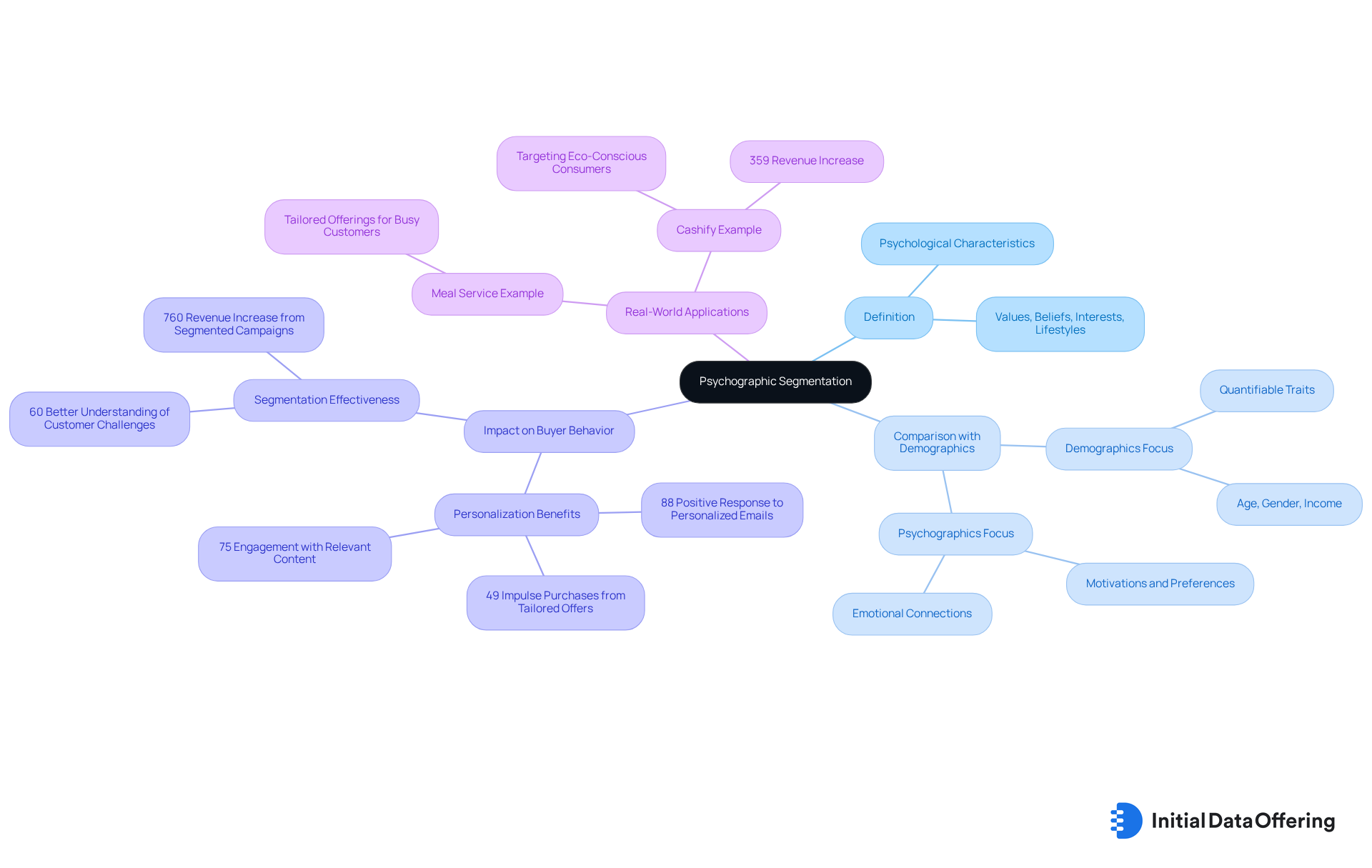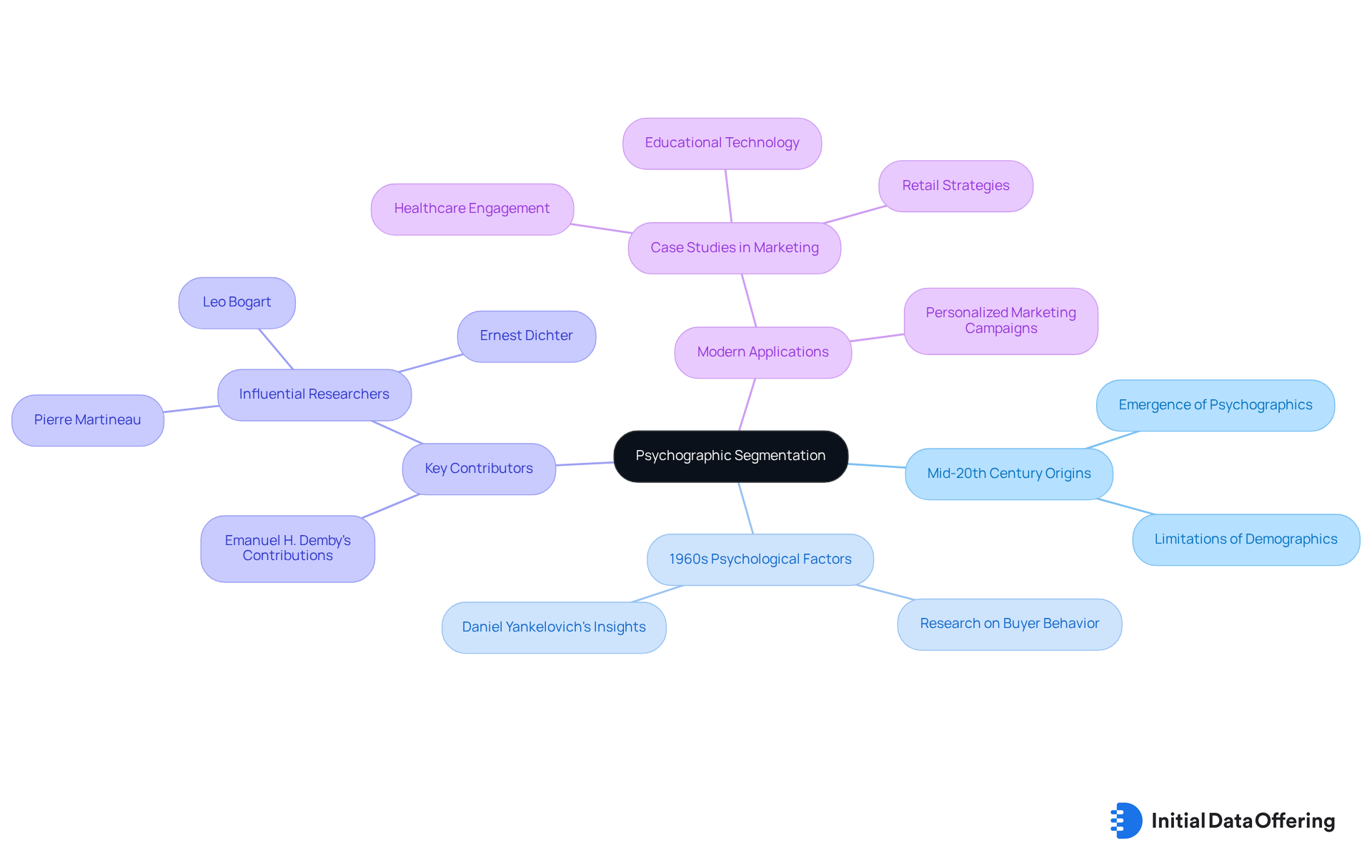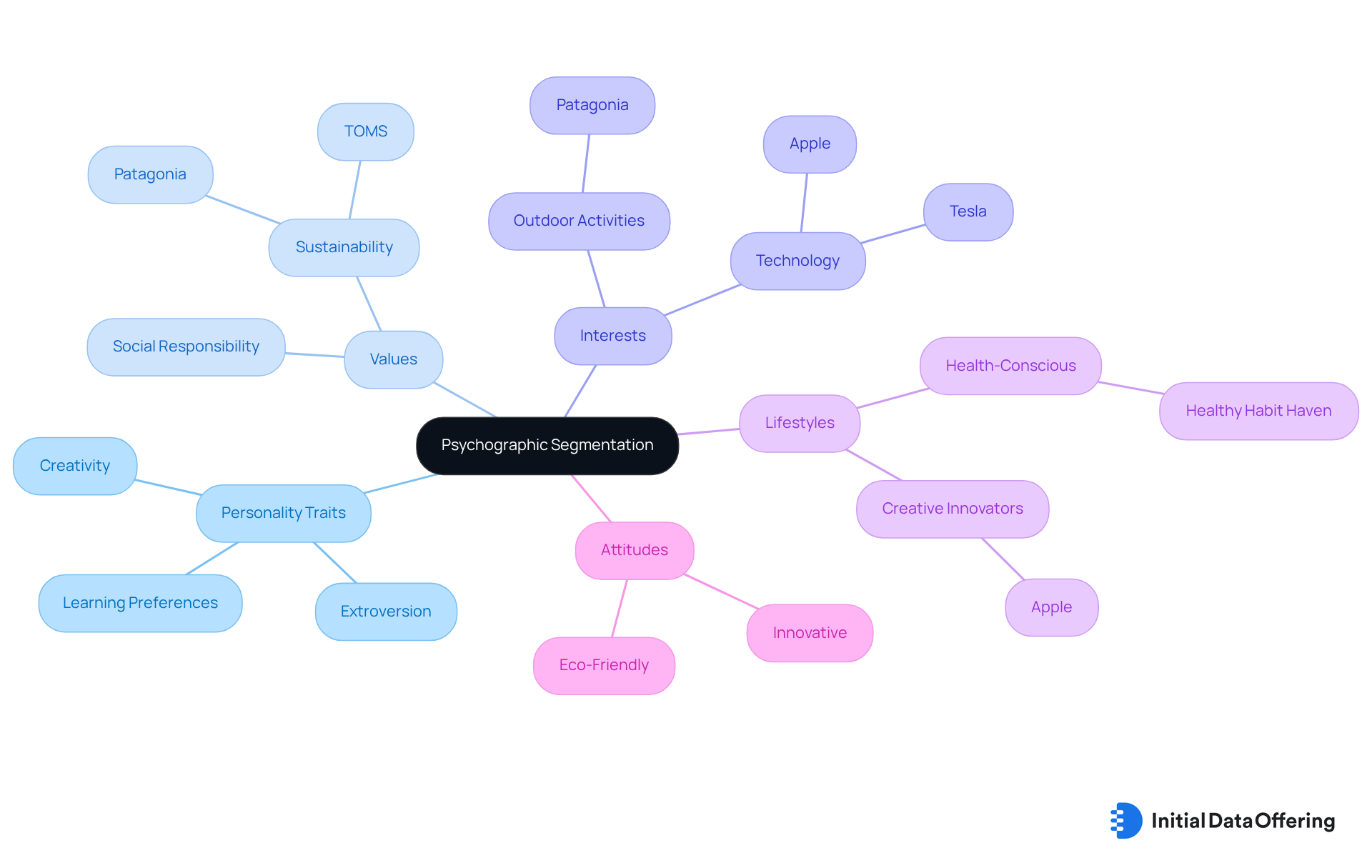What is Psychographic: Definition, Origins, and Key Components

What is Psychographic: Definition, Origins, and Key Components
Overview
Psychographic segmentation is a marketing approach that categorizes individuals based on their psychological characteristics, including values, beliefs, interests, and lifestyles. This method allows businesses to understand the motivations behind consumer behavior. By leveraging psychographic insights, companies can create tailored messages that resonate emotionally with their audience. This personalization enhances marketing strategies, leading to improved engagement and better business outcomes.
How can your organization utilize psychographic segmentation to connect more deeply with its customers?
Introduction
Psychographic segmentation signifies a transformative shift in marketing strategies, moving beyond traditional demographic classifications to explore the psychological attributes that influence consumer behavior. This approach allows businesses to understand values, beliefs, and lifestyles, enabling them to craft tailored messages that resonate deeply with their audiences. As a result, companies can foster stronger emotional connections and enhance engagement.
However, as marketers increasingly embrace this nuanced strategy, a critical question emerges: how can organizations effectively leverage psychographic insights to not only bolster customer loyalty but also innovate their offerings in a rapidly evolving marketplace?
Define Psychographic Segmentation and Its Relevance
What is psychographic categorization? It represents an advanced marketing approach that classifies individuals based on their psychological characteristics, such as values, beliefs, interests, and lifestyles. This method stands in stark contrast to demographic segmentation, which emphasizes quantifiable traits like age, gender, and income. What is psychographic helps in delving into the motivations and preferences that drive buyer behavior, offering deeper insights into the 'why' behind purchasing decisions. This understanding is essential for effective targeting and engagement in today's competitive landscape.
The significance of psychological data in buyer behavior is underscored by its ability to enhance personalization in marketing strategies. Companies leveraging psychological insights can craft messages that forge emotional connections with their audience, resulting in improved customer engagement. For instance, studies reveal that:
- 88% of users are more likely to respond positively to personalized emails.
- 49% of participants reported making impulse purchases when presented with tailored offers.
- 75% of customers are more inclined to engage with content that resonates with their interests and values.
This highlights the power of audience segmentation in influencing purchasing behavior.
Numerous companies have successfully utilized psychological data for focused promotion. A notable example is a meal service company that tailored its offerings to busy customers by providing fully cooked meals and meal kits, effectively addressing their specific needs. Similarly, Cashify, a platform for second-hand gadgets, targeted eco-conscious individuals by promoting sustainable practices, resulting in a remarkable 359% increase in revenue. This case exemplifies how understanding customers' unique needs and preferences can lead to significant business outcomes.
In summary, what is psychographic classification enhances the understanding of buyer motivations and enables businesses to develop marketing strategies that align with their audience's core values and interests. As Alexandra Samuel notes, the internet has made understanding what is psychographic more practical and significant than ever, making this strategic focus crucial for fostering deeper relationships with clients and improving business results.

Trace the Origins and Evolution of Psychographic Segmentation
Psychographic segmentation emerged in the mid-20th century as marketers began to recognize the limitations of traditional demographic approaches. In the 1960s, researchers explored the psychological factors that affect purchasing behavior, marking the establishment of psychographics as a distinct field. Pioneers like Emanuel H. Demby played an essential role in formalizing psychological profiling, emphasizing the importance of understanding buyer motivations and attitudes. This foundational work paved the way for a deeper exploration of how psychological attributes shape purchasing decisions.
Over the decades, psychographic segmentation has evolved significantly, incorporating insights from behavioral science and sociology. This evolution has transformed psychographics into an essential tool for marketers aiming to forge more personal connections with consumers. By analyzing values, interests, and lifestyle choices, businesses can customize their promotional strategies to resonate with specific segments. Ultimately, this enhances engagement and conversion rates.
The impact of psychographic research is evident in various case studies, where organizations have successfully utilized these insights to refine their marketing approaches. For instance, in the educational technology sector, marketers have recognized distinct types of users, such as 'Enablers' who prioritize entertainment and 'Limiters' who focus on educational value. This nuanced understanding enables targeted messaging that aligns with customer motivations, leading to improved outcomes.
Experts in the field emphasize that the evolution of psychographic segmentation reflects a broader shift towards personalized, customer-centric strategies. By moving beyond traditional demographic traits, marketers can better forecast buyer behavior and create products and services that fulfill the specific needs of their target audiences. This method not only nurtures stronger connections with clients but also stimulates innovation across sectors, showcasing the lasting significance of psychographics in contemporary marketing.

Identify Key Components of Psychographic Segmentation
To understand what is psychographic segmentation, one must consider key components such as personality traits, values, interests, lifestyles, and attitudes. These factors play a crucial role in helping marketers create detailed buyer profiles that reflect the motivations behind purchasing decisions. For instance, a brand targeting environmentally conscious individuals may focus on principles related to sustainability and eco-friendliness. Furthermore, lifestyle factors, such as hobbies and social activities, provide valuable insights into how consumers interact with products and brands. By understanding what is psychographic, businesses can tailor their promotional strategies to resonate with the psychological profiles of their target audience.
Significantly, only 17% of organizations currently utilize AI-driven customer categorization, highlighting a substantial opportunity for brands to leverage behavioral insights more effectively. Companies like Healthy Habit Haven have successfully transformed their promotional strategies by integrating lifestyle segmentation, resulting in increased conversion rates and enhanced customer satisfaction. Moreover, understanding what is psychographic factors not only fosters customer loyalty but also boosts customer lifetime value (CLV), making it essential for brands to connect with clients on a deeper level. For example, Patagonia aligns its promotions with the values of outdoor enthusiasts and environmentally aware consumers, cultivating loyalty through a commitment to sustainability. Similarly, Apple focuses on 'Creative Innovators' by showcasing cutting-edge technology and design, appealing to consumers who prioritize innovation and aesthetics. This understanding empowers brands to create personalized experiences that resonate with their audiences.

Examine Real-World Applications of Psychographic Segmentation
Understanding what is psychographic segmentation has proven to be a powerful tool across various sectors, significantly influencing promotional strategies and customer engagement. For example, Nike effectively leverages insights about what is psychographic to connect with active individuals who prioritize fitness and performance. By tapping into their audience's motivations and aspirations, Nike crafts compelling promotional campaigns that resonate deeply with individuals' lifestyles. This strategy not only strengthens brand loyalty but also fosters a community of like-minded individuals who align with the brand's values.
In the beauty industry, brands frequently segment their audiences based on values related to self-expression and individuality. This approach allows them to tailor product offerings that directly appeal to individuals' desires for uniqueness and personal identity. Focused promotional strategies have been shown to enhance customer satisfaction and loyalty, as consumers feel recognized and valued.
Statistics indicate that brands employing psychological targeting can witness a significant boost in brand loyalty, with studies suggesting that targeted approaches may enhance customer retention rates by as much as 30%. This highlights what is psychographic in the context of personality-based segmentation and its effectiveness in forging meaningful connections between brands and their audiences.
Moreover, industry leaders underscore the importance of psychological strategies in modern promotion. For instance, Symanto emphasizes that understanding buyer motivations through psychological data enables brands to craft more impactful promotional communications, ultimately driving sales and fostering enduring connections with clients. Coca-Cola, for instance, effectively categorizes its audience into segments such as energetic individuals and family-oriented consumers, allowing it to create campaigns that resonate emotionally with these specific groups. These real-world applications demonstrate how psychographic segmentation not only boosts marketing effectiveness but also nurtures deeper emotional connections with consumers.

Conclusion
Psychographic segmentation emerges as a vital marketing strategy that transcends traditional demographic categorization by focusing on the psychological characteristics that drive consumer behavior. By understanding the values, beliefs, interests, and lifestyles of individuals, businesses can create more targeted and effective marketing campaigns that resonate deeply with their audiences.
The evolution and significance of psychographic segmentation are highlighted, tracing its origins back to the mid-20th century when marketers began recognizing the limitations of demographic approaches. Key components such as personality traits, values, and lifestyles are crucial in developing detailed buyer profiles. For instance, companies like Nike and Patagonia leverage psychographic insights to foster brand loyalty and enhance customer engagement. Furthermore, statistics underscore the effectiveness of psychological targeting in improving retention rates and driving sales.
Ultimately, embracing psychographic segmentation is not merely about refining marketing strategies; it is about forging meaningful connections with consumers. By tapping into the motivations that shape purchasing decisions, brands can cultivate loyalty and create personalized experiences that resonate with their target audiences. As the landscape of consumer behavior continues to evolve, the importance of understanding psychographics becomes increasingly clear. Marketers must prioritize these insights to remain competitive and foster lasting relationships with their clients.
Frequently Asked Questions
What is psychographic segmentation?
Psychographic segmentation is an advanced marketing approach that classifies individuals based on their psychological characteristics, such as values, beliefs, interests, and lifestyles.
How does psychographic segmentation differ from demographic segmentation?
Unlike demographic segmentation, which focuses on quantifiable traits like age, gender, and income, psychographic segmentation delves into the motivations and preferences that drive buyer behavior.
Why is understanding psychographic data important for businesses?
Understanding psychographic data enhances personalization in marketing strategies, allowing companies to craft messages that create emotional connections with their audience, leading to improved customer engagement.
What impact does personalization have on consumer behavior?
Personalization significantly influences consumer behavior, with studies showing that 88% of users are more likely to respond positively to personalized emails, and 49% reported making impulse purchases when presented with tailored offers.
Can you provide examples of companies successfully using psychographic segmentation?
Yes, a meal service company tailored its offerings to busy customers by providing fully cooked meals and meal kits. Similarly, Cashify targeted eco-conscious individuals with sustainable practices, resulting in a 359% increase in revenue.
How does psychographic classification enhance marketing strategies?
Psychographic classification enhances marketing strategies by improving the understanding of buyer motivations, enabling businesses to align their marketing efforts with their audience's core values and interests.
Why is psychographic segmentation becoming more significant in today's marketing landscape?
Psychographic segmentation is increasingly significant due to the internet's ability to facilitate deeper insights into consumer behavior, making it crucial for fostering relationships with clients and improving business results.